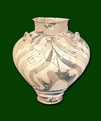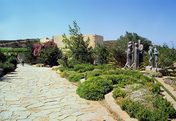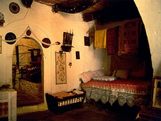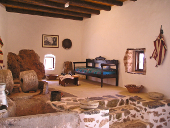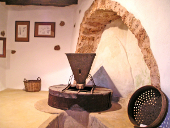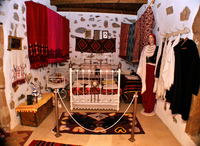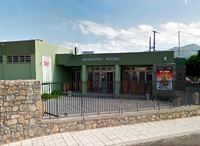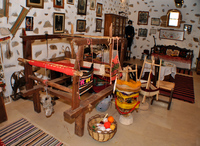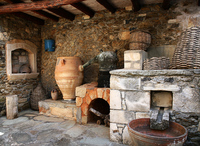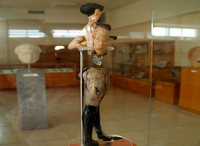The Archeological Museum of Sitia
The long archaeological and historical research at the Sitia area has brought to light rare and valuable finds and information of all civilizations from the Neolithic Age and the Minoan period to the New Age. The civilizations that have flourished the grounds of Sitia, one of the richest areas in archaeological sites internationally have bequeathed us magnificent samples of material and intellectual wealth that are exhibited in the district Museums and Collections.
One of the most important Cretan Museums is located in the Sitia town. In the town's archaeological museum are placed important finds of Minoan Civilization and other archaic Cretan civilizations. Unique exhibits of the excavations in Zakros, Mochlos, Psira, Palekastro, Itanos, Agia Fotia and other significant Minoan hubs in central Crete present a new experience for the visitor. Many of the exhibits refer to the olive, the vine cutlery, fishing bee- keeping as to other sectors of rural activity.
There are important folklore museums in Chamezi and Palekastro and minor folklore collections in Chandra and Pefkoi. In spaces fit out for exhibitions you find items that represent the Cretan folk culture and the rural and pastoral life. Three kilometers in the east of Sitia next to the Road to TOPLOU - Vai is built by the Sitia touring Club a large and well equipped Centre of Traditional Culture with Folklore Collections, Art Workshops, show rooms - selling points- rooms for trying local products, cinemas, multiple purpose halls, exhibition halls etc.
The Museums of the Toplou Monastery
The monasteries of the province serve as museums of very important heirlooms, witnesses of the centuries-old monastic tradition of the region. Within the building complex of the Toplou monastery, there are two very important museums. A museum of icons and books, religious heirlooms and ecclesiastical objects; and a museum of engraving and historical heirlooms. But also the monastery alone is a brilliant and exceptionally interesting monument that has been recently restored.
The Folklore Museum of Sitia
The Folklore Museum of Sitia was founded in 1975 by the educational and cultural association "Vintsenzos Kornaros". It contains many important folklore exhibits; mainly hand woven materials, embroideries, local costumes, furniture:
Embroideries
It includes linen table clothes, cotton handmade pillows, bedcovers and clothes. Hand-woven drapes with images of ancient gods and semi gods like Eros, Aphrodite and Pan. Cotton linen and silk towels, woven and adorned with various patterns.
Woven
A large variety of woven products like carpets, rugs, carrying bags, cloaks.
Furniture
Various handmade furniture including the iron bed, pictured on the top of this page, wooden cases for storing clothes and produce, a children's rocking bed. Most wooden furniture on display is also hand carved with various motifs, and pictures from the Cretan history.
Handiworks
A variety of hand made and polished mirrors, various small boxes for every day use like a newspaper rack, a toiletries box etc., Also some clocks in hand carved cases, pictures frames constructed from wood and decorated with silk.
Costumes
Some costumes are on display, depicting the typical dressing of the locals in older times. This includes the clothes worn by a typical farmer, a typical dress worn by a lady at the beginning of the century, etc.
Kitchenware
Various cooking utensils and equipment, like irons, rock and mills for grinding coffee, and flour, lamp stands, iron pots and pans.
Pots
Ceramic pans, pots and plates, water carafes, flower vases, glasses.
Icons
Some old Orthodox Christian icons are also on display.
Loom room
A complete loom with all its parts, on working condition, is on display. Here the visitor can examine the whole process of weaving. The loom is currently used by the museum staff, to produce artifacts on sale in the museum shop.
Woodcarving Museum in Tourtoulous
At the old forge which is currently being used as an exhibition hall after its restoration, displayed the artwork of the popular artist Manolis Th. Perakis- Chalkias (1910-2006). Chalkias, after having subdued iron material as a blacksmith an impressive piece of his work is the handmade quintal, "kandari" (a traditional scale) - he also tried to express himself artisticly working on raw wood material for 35 whole years (from 1971 till his death).
Inspired by nature, Manolis Th. Perakis- Chalkias created various realistic, as well as imaginary shapes. The main raw materials he used were the natural wood of medlar tree (despolia), mandarin tree, orange tree, olive tree, pear tree etc. Some of the artist's favourite topics are: portraits (Christ's, Virgin Mary's), busts of political persons (Eleftherios Venizelos), ornamented useful things, musical instruments ( the lyre and the violin), incomprehensible animal complexes, monstrous birds and supernatural reptiles.
All he created, using his imagination, became true as he engraved wood. Naturalness, simplicity and uniqueness dominate upon his craftwork. Chalkia's handmade artistry is based on traditional tools such as hack hammers, chisels, saws and sharpeners. When artist's hands "talk" we can do nothing more than remain silent enjoying his work!
Zakros Museum of water and Hydraulic
Zakros, one of the biggest villages in the Eastern Crete, known for the Minoan Palace in Kato Zakros but also for the abundance of water, the springs and the ravines with plan trees.
The existence of water has always had the most vital part in the inhabitants' economical and social activities. The structure, the neighborhoods, the inhabitants' activities have a parallel course with the "water's path". A path that has been carved by the force of the movement of water for thousands of years, starting from the biggest spring in Zakros called "Mesa Mylos" reaching the gorge and continuing its course towards the sea.
The settlement was built along the course of water giving it this long shaping which it still has in our days. In the beginning the inhabitants grew only small vegetable gardens for their every day needs but later large expanses with olive trees were cultivated which are today fully irrigated and they produce Zakro's distinguished olive oil.
People couldn't leave unexploited the possibility given by water to move the engines they have invented to produce goods and improve their living standards. Therefore having taken advantage of the hydraulic power and the area's relief people built watermills along this water path in order to grind grain, small factories to produce olive oil and rasotrivia* to process woolen textile.
In the early 1900s Zakros constituted the center of an idiosyncratic "industrial area" since there were 11 watermills functioning. The watermill is considered to be the "factory" of the pre-industrial era.
A smart and simply functioned construction exploits the water power to move millstones while the whole process was under the control of only one person, the miller.
The grain usually grinded was barley and weat, which was cultivated around Zakros and the nearby areas. Many were those who came a long distance to grind the grain at the watermills of Zakros. The construction of a watermill was mainly of a simple right-angle shaping including the workroom, and in larger watermills, a room for the reception of customers and the miller's residence with a fireplace for cooking and heating. Next to the watermill there used to be a stable for animals and sometimes a wood-oven.
The well is probably the most impressive element as far as construction is concerned. Located above the watermills, 6 to 8 meters in height, it forwards the water to a propeller which moves the millstones to grind the grain which fell off the basket slowly and steadily always under the miller's supervision.
The Museum of Water in Zakros is housed in the restored watermills which were given away by the owner families in 1997. It is a theme museum whose aim is to gather every object or other material relative to the use of water in the past and also to make the importance of water known in our days as well, exploiting it correctly through rational use and respect.
The watermills which have been restored and formed to exhibitions are:
- "Brilakenas'" watermill. It was a property of Brilakis and N. Rodanakis family, built before 1900. there is a rasotrivio* nearby owned by N. Rodanakis.
- "Rodanovagelis'" watermill, built before 1900 by Vagelis Rodanakis' father. In the same space an olive oil factory functioned with the power of water.
- "Xopapa's" watermill, one of the oldest watermills. There is a wood-oven right outside.
rasotrivio* Small factory which processed woolen textile made




